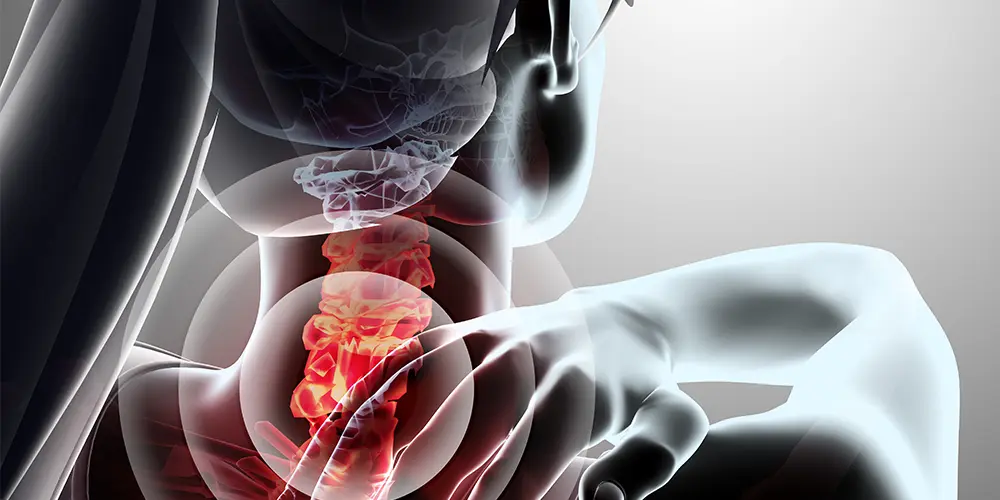Neck Pain- and Whiplash-Associated Disorders: A Cohort Study
Neck pain is one of the most common musculoskeletal disorders with a lifetime prevalence of 54%. Some of those who experience neck pain develop chronic symptoms. The mechanisms that lead from acute to chronic neck pain are not fully understood yet, and the treatment of neck pain is often unsatisfactory as it is centred around a biomedical approach. Research on the topic is therefore urgently needed.

Background
This study observes the course of neck pain in a patient cohort over one year. Of main interest are the associations between physical and psychosocial factors and their influence on the remission of acute neck pain. Results from this study can inform the prevention and treatment of neck pain or whiplash-associated disorders in the future. Neck pain-associated disorders (NAD) and whiplash-associated disorders (WAD) are major health problems. Although most patients recover from acute neck pain within the first three months, some develop persistent pain. Whiplash occurs less frequently, but those affected often suffer more severely from a wide variety of complaints. Patients who develop chronic symptoms experience recurring pain, leading to a reduced quality of life. On a macro level, NAD represents a considerable burden in terms of health care spending and social costs. The exact mechanisms that lead to chronic neck pain are not yet fully understood. Recent scientific findings show a close relationship between physical and psychosocial factors that may influence the course of neck pain and lead to chronic disability. Relevant psychosocial risk factors include:
- Distress, depressive symptoms, and anxiety
- Unrealistic expectations of recovery and illness perception
- Suboptimal pain-related activity patterns, e.g. avoidance or overactivity
- Maladaptive coping behaviours.
These findings reflect the necessity to identify factors predictive of pain outcomes, to understand their associations and how they relate to the persistence of symptoms. Early interventions that consider the different factors influencing the course of neck pain would save costs and improve individual outcomes.
Objective
This prospective cohort study aims to observe clinical factors, such as pain, body perception, or movement control and psychosocial factors, such as stress, depressive symptoms, or anxiety, in a cohort of individuals with NAD or WAD over one year. In a subgroup of participants, the representation of the cervical spine will be assessed using functional MRI (fMRI) to investigate neuroplastic changes in sensorimotor networks. The results of this study have the potential to be translated into target-group-oriented assessment, treatment and prevention of NAD and WAD by different health care professionals.
Methods and Procedure
The NAD and WAD cohorts will be followed for 12 months after pain onset with 3 clinical assessments and 4 surveys administered via an online questionnaire.
Inclusion criteria:
- Acute neck pain or whiplash-associated disorder (for a maximum duration of 4 weeks)
- In case of recurring neck pain, pain-free for at least three months before the onset of the current pain
- Age between 18 and 65 years
- German language skills for answering the online questionnaire
Clinical Assessments:
Participation in physical examinations at local testing centres
- 3 appointments within one year (1, 3 and 6 months after the onset of neck pain)
- Month 1, 3, and 6: Assessment of pain, body perception and movement control
- Month 1 and 6: Analysis of hair cortisol concentrations as a biomarker for long-term stress
- Duration of clinical assessment: ca. 30 - 60 minutes
- In a subgroup: functional MRI assessment; duration: ca. 90 minutes
Questionnaire:
Survey via an online questionnaire on a PC or smartphone at four time points within a year (1,3, 6 and 12 months) with questions about:
- Pain perception
- Psychosocial factors such as stress, behaviour, attention
- Physical activity
Answering these questions at home or at the local test centre takes about 30 minutes. All data will be treated confidentially. In the event of non-participation, all personal data will be deleted.
Project Partners
- Project lead
Prof. Dr. Sabina Hotz Boendermaker - Project duration
01.05.2022 – 30.03.2026 - Project Team
Prof. Dr. Hannu Luomajoki, Leah Reicherzer; MSc, Rita Morf, MSc, cand. PhD - Project partners
University Hospital Zurich, Department of Neuroradiology
Medbase Gruppe
Medbase Winterthur Archhöfe
Physion Meilen - Funding
This study is financed by the Swiss National Science Foundation (SNF). - Project status
Current
Project Organisation
- Project leadership
Dr. Sabina Hotz Boendermaker - Project duration
01.05.2022 – 30.04.2026 - Project team
Prof. Dr. Hannu Luomajoki, Markus Ernst, Leah Reicherzer, MSc, Rita Morf, MSc, cand. PhD - Project partners
University Hospital Zurich, Departement of Neuroradiology
Medbase Groupe
Medbase Winterthur Archhöfe
Physion Meilen
University of Zurich, Departement of Economics - Funding
This study is financed by the Swiss National Science Foundation (SNF). - Project status
Current


